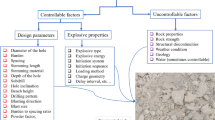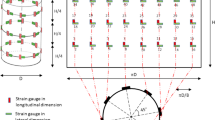Abstract
Buried pipelines are one of the critical lifeline structures, and recently, efforts have been directed toward their probabilistic risk assessment. This paper explores the fragility analysis of buried pipelines due to permanent fault displacement. Although several studies have been carried out for the fragility analysis of buried pipelines, they are conditioned only on one significant input parameter. Unlike previous studies, the fragility curves presented in this paper are multi-dimensional, i.e., conditioned on all the significant input parameters. The fragility curves are generated using a machine learning technique called Lasso regression. This paper also explores the relative importance of various uncertain parameters on the fragility estimates. The fragility analysis results suggest that the fault displacement and fault–pipe crossing angle are the most important parameters.









Similar content being viewed by others
References
Abdoun TH, Ha D, O’Rourke MJ, Symans MD, O’Rourke TD, Palmer MC, Stewart HE (2009) Factors influencing the behavior of buried pipelines subjected to earthquake faulting. Soil Dyn Earthq Eng 29(3):415–427
ALA (2001) Guidelines for the design of buried steel pipe. A report by public-private partnership between American Society of Civil Engineers (ASCE) & Federal Emergency Management Agency (FEMA), American Lifeline Alliance (ALA)
ALA (2001) Seismic fragility formulations for water systems. A report by public-private partnership between American Society of Civil Engineers (ASCE) & Federal Emergency Management Agency (FEMA), American Lifeline Alliance (ALA)
ASCE (1984) Guidelines for the seismic design of oil and gas pipeline systems, American Society of Civil Engineers, Committee on Gas Liquid Fuel Lifelines
Briaud J-L (2000) The national geotechnical experimentation sites at Texas A&M University: clay and sand. A summary. National Geotechnical Experimentation Sites. Geotech Spec Publ 93:26–51
Burnett AJ (2015) Investigation of full scale horizontal pipe-soil interaction and large strain behaviour of sand. Master thesis, Queen’s University, Kingston, ON, Canada
Cheng Y, Akkar S (2017) Probabilistic permanent fault displacement hazard via Monte Carlo simulation and its consideration for the probabilistic risk assessment of buried continuous steel pipelines. Earthq Eng Struct Dyn 46(4):605–620
Cocchetti G, di Prisco C, Galli A, Nova R (2009) Soil-pipeline interaction along unstable slopes: a coupled three-dimensional approach. Part 1: theoretical formulation. Can Geotech J 46(11):1289–1304
Dukes JD (2013) Application of bridge specific fragility analysis in the seismic design process of bridges in California. Ph.D. thesis, School of Civil and Environmental Engineering, Georgia Institute of Technology, Atlanta, USA
Duncan JM (2000) Factors of safety and reliability in geotechnical engineering. J Geotech Geoenviron Eng 126(4):307–316
FEMA (Federal Emergency Management Agency) (2004) Multi-hazard loss estimation methodology—earthquake model: HAZUS MR4 technical manual. U.S. Department of Homeland Security, Federal Emergency Management Agency, Washington DC
Glisic B, Yao Y (2012) Fiber optic method for health assessment of pipelines subjected to earthquake-induced ground movement. Struct Health Monit 11(6):696–711
Gresnigt A (1986) Plastic design of buried steel pipelines in settlement areas. Heron 31(4):1–113
Ha D, Abdoun TH, O’Rourke MJ, Symans MD, O’Rourke TD, Palmer MC, Stewart HE (2008) Buried high-density polyethylene pipelines subjected to normal and strike-slip faulting—a centrifuge investigation. Can Geotech J 45(12):1733–1742
Honegger DG, Nyman DJ (2004) PRCI guidelines for the seismic design and assessment of natural gas and liquid hydrocarbon pipelines. Pipeline Research Council International, Technical Toolboxes, Houston
Jeon JS, Mangalathu S, Song J, DesRoches R (2017) Parameterized seismic fragility curves for curved multi-frame concrete box-girder bridges using Bayesian parameter estimation. J Earthq Eng. https://doi.org/10.1080/13632469.2017.1342291
Karamitros DK, Bouckovalas GD, Kouretzis GP, Gkesouli V (2011) An analytical method for strength verification of buried steel pipelines at normal fault crossings. Soil Dyn Earthq Eng 31(11):1452–1464
Katayama T, Kubo K, Sato N (1975) Earthquake damage to water and gas distribution systems. U.S. National Conference on Earthquake Engineering, EERI, Oakland, pp 396–405
Kennedy RP, Chow AW, Williamson RA (1977) Fault movement effects on buried oil pipeline. J Transp Eng 103(5):617–633
Kim J, Nadukuru S, Pour-Ghaz M, Lynch J, Michalowski R, Bradshaw A, Green R, Weiss W (2012) Assessment of the behavior of buried concrete pipelines subjected to ground rupture: experimental study. J Pipeline Syst Eng Pract 3(1):8–16
Klar A, Marshall AM (2008) Shell versus beam representation of pipes in the evaluation of tunneling effects on pipelines. Tunn Undergr Space Technol 23(4):431–437
Kouretzis GP, Karamitros DK, Sloan SW (2015) Analysis of buried pipelines subjected to ground surface settlement and heave. Can Geotech J 52(8):1058–1071
Lanzano G, Salzano E, de Magistris FS, Fabbrocino G (2013) Seismic vulnerability of natural gas pipelines. Reliab Eng Syst Saf 117:73–80
Lee DH, Kim BH, Jeong S-H, Jeon J-S, Lee T-H (2016) Seismic fragility analysis of a buried gas pipeline based on nonlinear time-history analysis. Int J Steel Struct 16(1):231–242
Mangalathu S (2017) Performance based grouping and fragility analysis of box-girder bridges in California. Ph.D. Thesis, School of Civil and Environmental Engineering, Georgia Institute of Technology, Atlanta, USA
Mangalathu S, Jeon JS, DesRoches R (2018) Critical uncertainty parameters influencing seismic performance of bridges using lasso regression. Earthq Eng Struct Dyn 47(3):784–801
Mangalathu S, Jeon JS, Soleimani F, DesRoches R, Padgett JE, Jiang J (2015) Seismic vulnerability of multi-span bridges: an analytical perspective. In: 10th Pacific conference on earthquake engineering, Sydney, Australia
Mokhtari M, Alavi Nia A (2015) The influence of using CFRP wraps on performance of buried steel pipelines under permanent ground deformations. Soil Dyn Earthq Eng 73:29–41
Newmark NM, Hall WJ (1975) Pipeline design to resist large fault displacement. In: U.S. national conference on earthquake engineering, University of Michigan, Ann Arbor, MI, USA, pp 416–425
Ng CWW, Cai Q, Hu P (2012) Centrifuge and numerical modeling of normal fault-rupture propagation in clay with and without a preexisting fracture. J Geotech Geoenviron Eng 138(12):1492–1502
Ni P, Mangalathu S (2018) Fragility analysis of gray iron pipelines subjected to tunneling induced ground settlement. Tunn Undergr Space Technol 76:133–144
Ni P, Mangalathu S (2018) Simplified evaluation of pipe strains crossing a normal fault through the dissipated energy method. Eng Struct 167:393–406
Ni P, Mangalathu S, Yi Y (2018) Fragility analysis of continuous pipelines subject to transverse permanent ground deformation. Soils Found. https://doi.org/10.1016/j.sandf.2018.08.002
Ni P, Moore ID, Take WA (2014) The interaction of normal faults with pipelines: experimental observation and finite element modeling. In: Annual conference of the Canadian society for civil engineering 2014: sustainable municipalities, CSCE 2014, Halifax, NS
Ni P, Moore ID, Take WA (2018) Distributed fibre optic sensing of strains on buried full-scale PVC pipelines crossing a normal fault. Géotechnique 68(1):1–17
Ni P, Moore ID, Take WA (2018) Numerical modeling of normal fault-pipeline interaction and comparison with centrifuge tests. Soil Dyn Earthq Eng 105:127–138
O’Rourke MJ (2009) Analytical fragility relations for buried segmented pipe. In: Proceddings of the TCLEE 2009, lifeline earthquake engineering in a multihazard environment
O’Rourke MJ, Ayala G (1993) Pipeline damage due to wave propagation. J Geotech Eng 119(9):1490–1498
O’Rourke MJ, Filipov E, Uçkan E (2015) Towards robust fragility relations for buried segmented pipe in ground strain areas. Earthq Spectra 31(3):1839–1858
O’Rourke MJ, Liu X (2012) Seismic design of buried and offshore pipelines. Monograph MCEER-12-MN04, Multidisciplinary Center for Earthquake Engineering Research, University at Buffalo, State University of New York, Buffalo, NY, USA
O’Rourke TD, Jung JK, Argyrou C (2016) Underground pipeline response to earthquake-induced ground deformation. Soil Dyn Earthq Eng 91:272–283
Popescu R, Deodatis G, Nobahar A (2005) Effects of random heterogeneity of soil properties on bearing capacity. Probab Eng Mech 20(4):324–341
Rahman MA, Taniyama H (2015) Analysis of a buried pipeline subjected to fault displacement: a DEM and FEM study. Soil Dyn Earthq Eng 71:49–62
Rajeev P, Kodikara J (2011) Numerical analysis of an experimental pipe buried in swelling soil. Comput Geotech 38(7):897–904
Rojhani M, Moradi M, Galandarzadeh A, Takada S (2012) Centrifuge modeling of buried continuous pipelines subjected to reverse faulting. Can Geotech J 49(6):659–670
Saiyar M, Ni P, Take WA, Moore ID (2016) Response of pipelines of differing flexural stiffness to normal faulting. Géotechnique 66(4):275–286
Seo J, Linzell DG (2013) Use of response surface metamodels to generate system level fragilities for existing curved steel bridges. Eng Struct 52:642–653
Shi J, Wang Y, Chen Y (2018) A simplified method to estimate curvatures of continuous pipelines induced by normal fault movement. Can Geotech J 55(3):343–352
Shokrabadi M, Banazadeh M, Shokrabadi M, Mellati A (2015) Assessment of seismic risks in code conforming reinforced concrete frames. Eng Struct 98:14–28
Sim WW, Towhata I, Yamada S (2012) One-g shaking-table experiments on buried pipelines crossing a strike-slip fault. Geotechnique 62(12):1067–1079
Tibshirani R (1996) Regression shrinkage and selection via the lasso. J R Stat Soc 58(1):267–288
Trifonov OV, Cherniy VP (2010) A semi-analytical approach to a nonlinear stress strain analysis of buried steel pipelines crossing active faults. Soil Dyn Earthq Eng 30(11):1298–1308
Uçkan E, Akbas B, Shen J, Rou W, Paolacci F, O’Rourke MJ (2015) A simplified analysis model for determining the seismic response of buried steel pipes at strike-slip fault crossings. Soil Dyn Earthq Eng 75:55–65
Vazouras P, Karamanos SA, Dakoulas P (2010) Finite element analysis of buried steel pipelines under strike-slip fault displacements. Soil Dyn Earthq Eng 30(11):1361–1376
Wang B, Li X, Zhou J (2011) Strain analysis of buried steel pipelines across strike-slip faults. J Cent South Univ Technol 18(5):1654–1661
Wang Y, Au S-K, Cao Z (2010) Bayesian approach for probabilistic characterization of sand friction angles. Eng Geol 114(3):354–363
Wijewickreme D, Honegger DG, Mitchell A, Fitzell T (2005) Seismic vulnerability assessment and retrofit of a major natural gas pipeline system: a case history. Earthq Spectra 21(2):539–567
Xie XJ, Symans MD, O’Rourke MJ, Abdoun TH, O’Rourke TD, Palmer MC, Stewart HE (2013) Numerical modeling of buried HDPE pipelines subjected to normal faulting: a case study. Earthq Spectra 29(2):609–632
Zhou M, Wang F, Du Y-J, Liu MD (2018) Laboratory evaluation of buried high-density polyethylene pipes subjected to localized ground subsidence. Acta Geotech. https://doi.org/10.1007/s11440-018-0698-6
Zhou W (2012) Reliability of pressurised pipelines subjected to longitudinal ground movement. Struct Infrastruct Eng 8(12):1123–1135
Acknowledgements
This work was supported by the National Natural Science Foundation of China (Grant No. 51608461), the Fundamental Research Funds for the Central Universities (Grant No. 2682016CX019), the open research fund of MOE Key Laboratory of High-speed Railway Engineering, Southwest Jiaotong University, and the State Key Laboratory for GeoMechanics and Deep Underground Engineering, China University of Mining & Technology (Grant No. SKLGDUEK1726).
Author information
Authors and Affiliations
Corresponding author
Additional information
Publisher's Note
Springer Nature remains neutral with regard to jurisdictional claims in published maps and institutional affiliations.
Rights and permissions
About this article
Cite this article
Ni, P., Mangalathu, S. & Liu, K. Enhanced fragility analysis of buried pipelines through Lasso regression. Acta Geotech. 15, 471–487 (2020). https://doi.org/10.1007/s11440-018-0719-5
Received:
Accepted:
Published:
Issue Date:
DOI: https://doi.org/10.1007/s11440-018-0719-5




